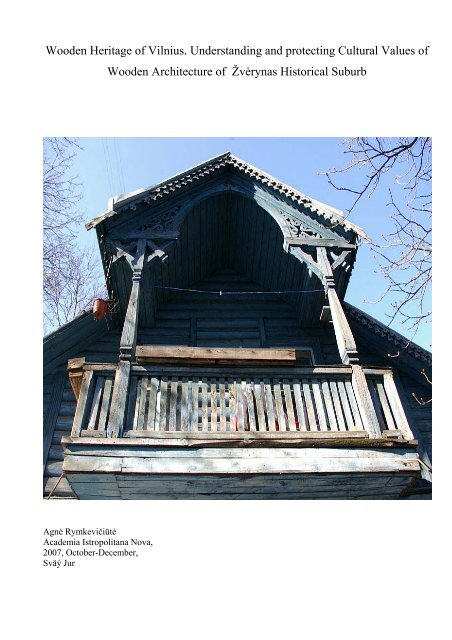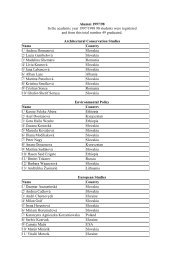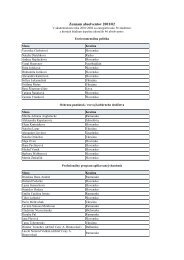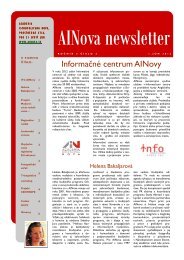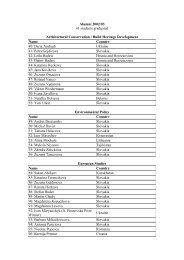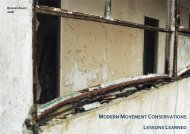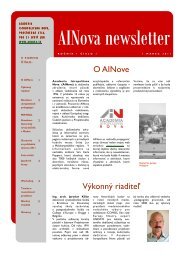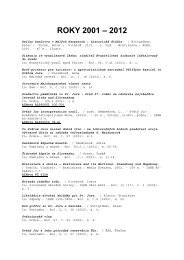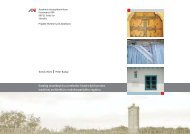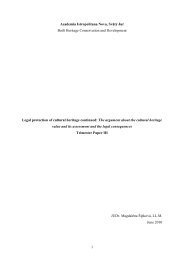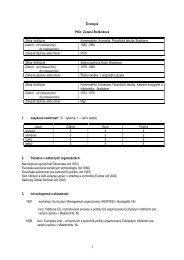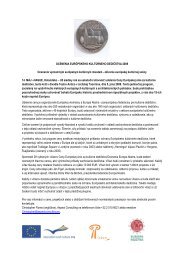Wooden Heritage of Vilnius - Academia Istropolitana Nova
Wooden Heritage of Vilnius - Academia Istropolitana Nova
Wooden Heritage of Vilnius - Academia Istropolitana Nova
You also want an ePaper? Increase the reach of your titles
YUMPU automatically turns print PDFs into web optimized ePapers that Google loves.
<strong>Wooden</strong> <strong>Heritage</strong> <strong>of</strong> <strong>Vilnius</strong>. Understanding and protecting Cultural Values <strong>of</strong><br />
<strong>Wooden</strong> Architecture <strong>of</strong> Žvėrynas Historical Suburb<br />
Agnė Rymkevičiūtė<br />
<strong>Academia</strong> <strong>Istropolitana</strong> <strong>Nova</strong>,<br />
2007, October-December,<br />
Sväý Jur
Content<br />
Introduction…………………………………………………………………………………………3<br />
1. Historic and geographic survey <strong>of</strong> Žvėrynas historical suburb…………………………………..7<br />
2. Cultural values and cultural significance <strong>of</strong> heritage: a theoretical reflection…………………...9<br />
3. Understanding and protecting cultural values <strong>of</strong> wooden architecture <strong>of</strong> Žvėrynas historical<br />
suburb……………………………………………………………………………………………….12<br />
3.1. Articulation <strong>of</strong> cultural significance <strong>of</strong> wooden heritage in decision-type documents <strong>of</strong> <strong>of</strong>ficial<br />
institutions……………………………………………………………………………….……..……12<br />
3.2. The position <strong>of</strong> locals in respect <strong>of</strong> wooden architecture <strong>of</strong> Žvėrynas historical suburb..….14<br />
3.3. Cultural values <strong>of</strong> Žvėrynas wooden architecture with reference to historical records and other<br />
investigative works………………………………………………………………………….....….…14<br />
4. Protection <strong>of</strong> wooden architecture <strong>of</strong> Žvėrynas historical suburb: range <strong>of</strong> threats and<br />
problems……………………………………………………………………………………………….20<br />
5. Proposals for the preservation <strong>of</strong> wooden architecture in Žvėrynas………………………………..24<br />
Conclusions……………………………………………………………………………………..…..…25<br />
Literature…………………………………………………………………………………………........26<br />
Illustrations………………………………………………………………………………………….….27<br />
2
Introduction<br />
It is unique and specific that modern-day <strong>Vilnius</strong> is still rich with wooden architecture. Not only<br />
<strong>Vilnius</strong> but also other big Lithuanian towns maintained wooden areas in their old parts. The layers <strong>of</strong><br />
centuries here are more picturesque and more expressive than in many Western European towns –<br />
wooden buildings and <strong>of</strong> no value low-rise stone houses vanished there because <strong>of</strong> rapidly growing<br />
industry in 18 th -19 th century. This specificity <strong>of</strong> Lithuania towns is one <strong>of</strong> urban values, broadening the<br />
information field <strong>of</strong> the town.<br />
<strong>Wooden</strong> <strong>Vilnius</strong> is much younger, more chamberish and democratic city marginalia, compared to<br />
the centre or the old town. It fell into margins both in geographic and heritage preservation sense. It also<br />
fell into margins literally as it was pushed out into the suburbs and also figuratively as it took lower rank<br />
<strong>of</strong> cultural values in the hierarchy <strong>of</strong> heritage 1 .<br />
<strong>Wooden</strong> architecture heritage <strong>of</strong> central part <strong>of</strong> <strong>Vilnius</strong> constitute <strong>of</strong> approximately 2000 houses,<br />
mainly living ones (97 %), built in the middle <strong>of</strong> 19 th and beginning <strong>of</strong> 20 th century. It presents the<br />
traditional forms <strong>of</strong> vernacular wooden architecture or repeats the forms <strong>of</strong> pr<strong>of</strong>essional architecture.<br />
There are four large territories in the town where wooden architecture dominates (more than 75 %):<br />
Žvėrynas, Šnipiškės, Markučiai, Naujininkai. (fig.1, fig.2, fig.3) Besides there are twelve smaller<br />
territorial units and some single buildings 2 .<br />
The object <strong>of</strong> the work<br />
<strong>Wooden</strong> architecture <strong>of</strong> Žvėrynas historical suburb which is also an undivided urban unit per se - is<br />
the object <strong>of</strong> this work. It is essential to emphasize the integrity <strong>of</strong> wooden architecture and its<br />
environment whereas there is a threat to tend to protect a single object and to ignore its surrounding.<br />
While wooden Žvėrynas is a peculiar composition and example <strong>of</strong> the unity <strong>of</strong> architecture (not only<br />
wooden) and green places – the loss <strong>of</strong> symbiosis between the “woodies” and the green environment<br />
means also the losses <strong>of</strong> cultural values <strong>of</strong> this heritage<br />
<strong>Wooden</strong> houses in this area are mainly from the end <strong>of</strong> 19 th and beginning <strong>of</strong> 20th century. In<br />
contrast to the others historical suburbs, this one (together with Markučiai area) maintained almost<br />
untouched by the industrialization processes in the 6 th decade <strong>of</strong> 20 th century and kept its wooden face in<br />
concord with ambient natural places.<br />
1 Laučkaitė Laima, The Forgotten <strong>Wooden</strong> <strong>Vilnius</strong> // Surgailis Andrius. Medinis <strong>Vilnius</strong>. <strong>Wooden</strong> <strong>Vilnius</strong>. <strong>Vilnius</strong>: Versus<br />
Aureus, 2006, p. 10<br />
2 Medinės architektūros paveldo apsaugos strategijos įgyvendinimo programa. Vilniaus miesto savivaldybės tarybos<br />
sprendimas Nr. 1-1117. <strong>Vilnius</strong>, 2006, balandžio 26, 3 art., 4.<br />
3
It is necessary to mention that Žvėrynas urban site, namely the territory with the complex <strong>of</strong> wooden<br />
architecture 3 , is a listed object which is <strong>of</strong> local urban significance. (fig.1, fig.2, fig. 3)<br />
1 fig. <strong>Vilnius</strong> map and its main historical areas. Žvėrynas suburb is is on the left side <strong>of</strong> the map, surrounded<br />
by the river bend from the south.<br />
2 fig. Implementation <strong>of</strong> Conservation Strategy Programme Regarding <strong>Wooden</strong> Architecture <strong>of</strong> <strong>Vilnius</strong>.<br />
The main zones <strong>of</strong> wooden architecture are marked here. The zones <strong>of</strong> Žvėrynas (on the left side) and<br />
Šnipiškės (on the north side) historical suburbs contain more than 75 % <strong>of</strong> wooden buildings. Pink colour <strong>of</strong><br />
these zones in the map indicates the frameworks <strong>of</strong> urban protected areas.<br />
3 The territory including the streets <strong>of</strong> Latvių, Birutės, Traidenio, Maloniosios, Upės. Fig. 2 and fig. 3<br />
4
Problems <strong>of</strong> the work<br />
There are plenty <strong>of</strong> valuable wooden buildings in Žvėrynas suburb – 108 <strong>of</strong> 439 wooden houses are<br />
listed (there are 708 stone buildings). It should be noted that registering <strong>of</strong> objects is still ongoing process.<br />
According to <strong>Vilnius</strong> Technical University and Institute <strong>of</strong> Monuments Restoration executed research<br />
results (1990) more than 80% <strong>of</strong> protected wooden buildings are in a critical condition and demands<br />
major repairs. Present day condition <strong>of</strong> wooden architecture is not better in many cases. In spite <strong>of</strong> some<br />
decisional documents and strategic programmes concerning wooden architecture <strong>of</strong> <strong>Vilnius</strong> and issued by<br />
<strong>Vilnius</strong> Municipality and National Commission <strong>of</strong> Cultural <strong>Heritage</strong> (the latter is an advisory body in<br />
heritage issues) as well as <strong>of</strong> the fact <strong>of</strong> listing <strong>of</strong> single houses and the urban area, wooden face <strong>of</strong><br />
Žvėrynas is vanishing rapidly. Thus the following questions arise: why this heritage is doomed to<br />
disappear What are the threats which determine the disappearance <strong>of</strong> this heritage What are the main<br />
reasons <strong>of</strong> this indifference and disregard in respect <strong>of</strong> this heritage What should be done for<br />
preservation <strong>of</strong> wooden heritage <strong>of</strong> this suburb<br />
Aims <strong>of</strong> the work<br />
The main goal <strong>of</strong> the work is regeneration and identification <strong>of</strong> values related to cultural<br />
significance <strong>of</strong> wooden heritage <strong>of</strong> Žvėrynas. Understanding values is necessary process to start a<br />
sustainable preservation programme <strong>of</strong> it, to solve the existing problems and to give possible proposals in<br />
preservation <strong>of</strong> this heritage. Therefore the answers to these questions are significant:<br />
- What should it be protected and why should it be protected<br />
- Why is this object important and significant What are the cultural values <strong>of</strong> the object<br />
We argue that it is important to present some theoretical ideas about values <strong>of</strong> heritage. This will<br />
serve as a theoretical tool for the analysis <strong>of</strong> cultural values <strong>of</strong> Žvėrynas wooden architecture.<br />
Getty Conservation Institute‘s researches 4 on the subject <strong>of</strong> values and benefits <strong>of</strong> cultural heritage<br />
conservation as well as on values-based management will be instrumental and contributory for this work,<br />
mainly for the framework and directions in the concrete values-based research on wooden architecture <strong>of</strong><br />
the historical suburb <strong>of</strong> <strong>Vilnius</strong> town.<br />
Historical records and other investigative literature related to wooden architecture <strong>of</strong> the place will<br />
serve for the identification <strong>of</strong> cultural significance and values <strong>of</strong> the object. Besides, some <strong>of</strong>ficial<br />
documents will be analyzed in the light <strong>of</strong> perception <strong>of</strong> cultural values.<br />
4 Values and <strong>Heritage</strong> Conservation. Research report. The Getty Conservation Institute, Los Angeles, 2000 //<br />
http://www.getty.edu/gci and Port Arthur Historic Site. Port Arthur Historic Site Management Authority. A Case Study. Getty<br />
Conservation Institute, Los Angeles, 2003 // www.getty.edu/conservation<br />
5
Definitions<br />
It is important to define some principle definitions which are basic for this work. These are the<br />
definitions <strong>of</strong> cultural value and cultural significance.<br />
Cultural significance <strong>of</strong> the object <strong>of</strong> cultural heritage contains multiple values. From the writings<br />
<strong>of</strong> Austrian art critic Alois Riegl to the policies <strong>of</strong> the Burra charter 5 , cultural values have been ordered in<br />
categories, such as aesthetic, religious, political, economic, social, historic, etc. 6 These values are<br />
significant for the past, present or future generations 7 .<br />
In this work value is used to mean the characteristics attributed to heritage object, wooden<br />
architecture <strong>of</strong> Žvėrynas historical suburb, by legislation, heritage authorities, and/or other stakeholders.<br />
These characteristics are what make this site significant. Significance is used to mean the overall<br />
importance, determined through an analysis <strong>of</strong> the entirety <strong>of</strong> the values.<br />
Specifically for this work it is important to take a look at the main law for protecting immovable<br />
cultural heritage in Lithuania. Here we find the definition <strong>of</strong> valuable feature (synonym <strong>of</strong> cultural value)<br />
that is the feature <strong>of</strong> cultural object or place, or some their parts and elements, significant ethnically,<br />
historically, aesthetically or scientifically 8 . This definition is close to the one <strong>of</strong> Burra charter where<br />
cultural significance means aesthetic, historic, scientific, social or spiritual value for the past, present or<br />
future generations 9 .<br />
5 This charter is particularly focused on cultural heritage values and cultural significance <strong>of</strong> cultural heritage. It can be an<br />
adaptable model for site management in other parts <strong>of</strong> the world because the planning process it advocates requires the<br />
integration <strong>of</strong> local cultural values. – The Australia ICOMOS charter (The Burra charter) for the Conservation <strong>of</strong> Places <strong>of</strong><br />
Cultural Significance (1999). [Looked 2007 10 30]. On the Internet: <br />
6 Values and <strong>Heritage</strong> Conservation. Research Report. The Getty Conservation Institute. Los Angeles, 2000, p. 8<br />
7 The Australia ICOMOS charter (1999)…, article 1, 1.2<br />
8 Lietuvos Respublikos Nekilnojamųjų kultūros vertybių įstatymas. 2004, Nr. IX-2452, <strong>Vilnius</strong>, article 2, 40<br />
9 The Australia ICOMOS charter (1999)…, article 1, 1.2<br />
6
1. Historic and geographic survey <strong>of</strong> Žvėrynas historical suburb<br />
Historical reflection<br />
Žvėrynas as a <strong>Vilnius</strong> suburb had been developing under special conditions. This area, isolated by<br />
the natural fence <strong>of</strong> the river Neris, remained for a long time an untouched site <strong>of</strong> nature. The suburb was<br />
formed in short time-period - in the late 19 th and early 20 th century. Until present days it preserved a<br />
humane scale <strong>of</strong> the area as well as an atmosphere <strong>of</strong> a place historically intended for recreation 10 .<br />
The oldest information about Žvėrynas reaches the 16 th century. It is mentioned in the documents <strong>of</strong><br />
Radvilos, the noble family <strong>of</strong> Lithuania. Žvėrynas was the belonging <strong>of</strong> Radvilos noble family. This area<br />
was used as a fenced hunting territory with animals, kept in the forest precisely for that purpose. There<br />
were already some water ponds and water mill.<br />
In the 17 th century a part <strong>of</strong> Žvėrynas was shaped into a landscape park with rare species <strong>of</strong> trees,<br />
flower beds and animals.<br />
This area belonged to various owners during the 19 th century who continued hunting and organizing<br />
receptions <strong>of</strong> nobility. The springy slopes <strong>of</strong> the river Neris were cleared and planted with trees – the old<br />
oaks are growing also today. The Orthodox church <strong>of</strong> St. Catherine, the oldest sanctuary <strong>of</strong> the suburb,<br />
was build during this age. One more Orthodox church together with the Catholic church and Kenesa <strong>of</strong><br />
Karaites (Caraims) were built in the beginning <strong>of</strong> 20 th century.<br />
The constructions in Žvėrynas took a rather chaotic character, disregarding any special rules. Just<br />
after the sale <strong>of</strong> the area, in 1891, the south and the west part <strong>of</strong> it were regularly divided into squares.<br />
The plots in the forest area also used to be sold. We can see also now, that the streets in the eastern and<br />
northern part are curvy, shaped by the forms <strong>of</strong> nature 11 .<br />
Three periods <strong>of</strong> constructions in Žvėrynas can be singled. During the first period, until 1902, all<br />
built houses were wooden. This territory was advertised as a resort and recreation zone. It is important to<br />
mention that the suburb was connected with <strong>Vilnius</strong> town in 1902. <strong>Vilnius</strong> inhabitants loved this suburb<br />
and flew to live there as well as to rest and relax or entertain even before its incorporation into the town.<br />
During the second period <strong>of</strong> building, from 1903 till 1914, the most salient and specific examples <strong>of</strong><br />
wooden architecture were built. That was a period when a style <strong>of</strong> historicism corresponded to the fashion<br />
and taste <strong>of</strong> the time.<br />
The rationalism features are found in the houses built during the interwar period. That was a period<br />
when the stone architecture appeared in the neighbourhood <strong>of</strong> woodies. This period was distinguished for<br />
its manor style houses and Zakopane style which was characteristic to Poland, <strong>Vilnius</strong> and <strong>Vilnius</strong><br />
region 12 .<br />
10 Ptašek Marija. Medinė architektūra Vilniaus Žvėryno rajone // Medinė architektūra Lietuvoje, <strong>Vilnius</strong>, 2002<br />
11 http://www.zverynas.lt – an <strong>of</strong>ficial internet site <strong>of</strong> the community <strong>of</strong> Žvėrynas suburb. [looked 2007 10 25]<br />
12 Ptašek Marija. Medinė architektūra ..., p.<br />
7
Geographical situation and other specificities <strong>of</strong> the suburb<br />
The position <strong>of</strong> this suburb is rather specific – this is the area which locates between intensively<br />
built-up centre <strong>of</strong> the town and slopes <strong>of</strong> natural conservation area <strong>of</strong> Karoliniškės. It is as if moves from<br />
intensively urban environment to natural one. <strong>Wooden</strong> architecture <strong>of</strong> this area lives in concord with<br />
natural green places and thus creates a beautiful environment.<br />
3 fig. Žvėrynas historical suburb. The territory including streets <strong>of</strong> Latvių, Birutės, Traidenio, Maloniosios,<br />
Upės is the urban protected monument. This territory is the most dense wooden built area.<br />
Three zones are singled in this area: “riverside zone”, “forest zone” and “north zone”. In the green<br />
parts these places and objects are protected: slopes, springs, water ponds, relict pines. The specificities <strong>of</strong><br />
the zones must be taken into account when preparing the development plan <strong>of</strong> the suburb. However the<br />
unique environment is becoming more and more harmed because <strong>of</strong> new investments and new<br />
constructions.<br />
8
2. Cultural values and cultural significance <strong>of</strong> heritage: a theoretical reflection<br />
Values <strong>of</strong> cultural heritage are an important subject in contemporary society. Values are able to<br />
transform some objects and places into heritage. In the field <strong>of</strong> conservation <strong>of</strong> cultural heritage, values<br />
are basic to deciding what to conserve, why to conserve and how to conserve. The ultimate aim <strong>of</strong><br />
conservation is not to conserve material for its own sake but, rather, to maintain the values embodied by<br />
the heritage. It must be admitted that objects and places are not, in and <strong>of</strong> themselves, what is important<br />
about cultural heritage. They are important because <strong>of</strong> meanings and uses that people attaches to these<br />
material goods and the values they represent. Good, sustainable preservation <strong>of</strong> heritage examines why<br />
and how is heritage valued and by whom it is valued. The investigation <strong>of</strong> values and the answers to these<br />
questions will help to achieve that the heritage is meaningful to those whom it is intended to benefit 13 .<br />
There are some important challenges which face us in the field <strong>of</strong> conservation:<br />
- Physical condition <strong>of</strong> the cultural object or place and their maintenance;<br />
- Management context <strong>of</strong> cultural heritage: funds, trained personnel, legislative and political issues;<br />
- Cultural significance and values 14 .<br />
We will argue here that the identification <strong>of</strong> cultural values <strong>of</strong> the object and place and emphasis <strong>of</strong><br />
their significance is one <strong>of</strong> the most important issues that impact the physical condition <strong>of</strong> heritage objects<br />
and places as well as the management affairs. The process <strong>of</strong> valuing and categorizing values <strong>of</strong> the<br />
monument can serve as a vehicle to inform decisions about how best to preserve these values in the<br />
physical conservation <strong>of</strong> the object or place 15 .<br />
It is noticeable that in 20 th century, the conservation community and the heritage field have<br />
undergone an extraordinary expansion. There still are specialists – who are certainly needed – but new<br />
groups have become involved in the creation and care <strong>of</strong> heritage. The social factor in heritage<br />
conservation is specially emphasised in the Getty Institute’s research on values: instead <strong>of</strong> focusing on<br />
objects <strong>of</strong> conservation their research centres on subjects and involves an investigation <strong>of</strong> the different<br />
actors and institutions and their motivations, habits and other mediating factors. The group <strong>of</strong> citizens<br />
arrive with their own criteria and opinions on how to establish significance, on what merits conservation,<br />
and on how it should happen. The new definition <strong>of</strong> conservation, relevant for the research, can be raised<br />
here – it should be understood as a social process, one that includes the work <strong>of</strong> many individuals and<br />
groups, not just conservation specialists 16 . Here, the importance <strong>of</strong> social and economic values is<br />
acknowledged along with traditional notions <strong>of</strong> conservation value – such as age, aesthetics, and<br />
historical significance.<br />
13 Values and <strong>Heritage</strong> Conservation. Research report… , p. 7<br />
14 Ibid, p. 4<br />
15 Ibid, p. 7<br />
16 Ibid, p. 68<br />
9
<strong>Heritage</strong> can be valued in a variety <strong>of</strong> ways, driven by different motivations (economic, political,<br />
spiritual, aesthetic, etc.), each <strong>of</strong> which has correspondingly varied ideals and ethics. These different ways<br />
<strong>of</strong> valuing in turn lead to different approaches to preserving heritage. Here we must notice also the<br />
complexity <strong>of</strong> the contemporary society as well as the diversity <strong>of</strong> potential stakeholders <strong>of</strong> the heritage.<br />
Motivations for valorization (or devalorization) 17 <strong>of</strong> heritage may vary between different stakeholders and<br />
thus can create dissonances between existing values or added values. Cultural significance for the<br />
purposes <strong>of</strong> cultural heritage yet can be an issue <strong>of</strong> negotiation among pr<strong>of</strong>essionals, academics and<br />
community members who value the objects or place 18 .<br />
The behaviour in regard <strong>of</strong> cultural heritage, interpretation <strong>of</strong> it can be seen as a changeable, not a<br />
stable process. Values, given to heritage by individuals or communities may shift from time to time. Thus<br />
the values are not simply “preserved” but are, rather, modified. In the outcome, the meaning <strong>of</strong> the object<br />
or place is redefined, and new values can be sometimes created.<br />
One more landmark in the analysis <strong>of</strong> values can be taken into consideration. This is the<br />
significance <strong>of</strong> geographic scale. How to conserve the cultural heritage – at a local scale, national or<br />
global scale<br />
The new term <strong>of</strong> values-based management appears in the heritage valuing process. <strong>Heritage</strong><br />
management, which focuses on values’ identification with the primary purpose <strong>of</strong> protecting the<br />
significance <strong>of</strong> the place, is called values-based management. It must be said that values-based<br />
management has been most thoroughly formalized in Australia, where the Burra charter guides<br />
practitioners. While the principles <strong>of</strong> this management and the ideas <strong>of</strong> Burra charter can be adaptable<br />
also in the other parts <strong>of</strong> the world and serve as guidelines because the planning process it advocates<br />
requires the integrations <strong>of</strong> local cultural values. Values-based approaches starts by analyzing the values<br />
and significance attributed to cultural resources. This management is based on following issues:<br />
- Ability to accommodate many heritage types;<br />
- Ability to serve the diversity <strong>of</strong> interest groups;<br />
- Ability to address the range <strong>of</strong> threats to which heritage may be exposed;<br />
- Ability to propose a long-term view <strong>of</strong> management 19 .<br />
Some <strong>of</strong> these trends are especially important in preservation <strong>of</strong> the wooden architecture <strong>of</strong> the<br />
chosen <strong>Vilnius</strong> suburb.<br />
For establishing values <strong>of</strong> the object or site it is important to take into consideration:<br />
- Historical records;<br />
17 There is a subtle distinction between valuing - appreciating existing value, and valorizing - giving added value. - Values and<br />
<strong>Heritage</strong> Conservation. Research report… , p. 8<br />
18 Values and <strong>Heritage</strong> Conservation. Research report… , p. 9<br />
19 Port Arthur Historic Site. Port Arthur Historic Site Management Authority. A Case Study. The Getty Conservation Institute.<br />
Los Angeles, 2003, p. 1-2<br />
10
- Consultations <strong>of</strong> stakeholders – individuals and groups who have an interest in a site and who can<br />
provide valuable information about the contemporary values attributed to the place.<br />
11
3. Understanding and protecting cultural values <strong>of</strong> wooden architecture <strong>of</strong> Žvėrynas<br />
historical suburb<br />
<strong>Wooden</strong> architecture <strong>of</strong> Žvėrynas historical suburb is not evaluated adequately. The same may be<br />
said about all wooden architecture <strong>of</strong> <strong>Vilnius</strong> suburbs. This is one <strong>of</strong> the main reasons that determines the<br />
rapid decay or in some cases – even intentional destruction 20 – <strong>of</strong> this part <strong>of</strong> heritage. We will look at<br />
cultural significance <strong>of</strong> wooden architecture from several viewpoints:<br />
- How cultural significance <strong>of</strong> this heritage is defined in <strong>of</strong>ficial documents (These documents talks<br />
mainly generally about wooden architecture <strong>of</strong> Lithuania and <strong>Vilnius</strong> wooden architecture)<br />
- How this architecture is valued by <strong>Vilnius</strong> inhabitants and by Žvėrynas inhabitants<br />
- Cultural values <strong>of</strong> Žvėrynas wooden architecture with reference to historical records and other<br />
investigative works<br />
3.1. Articulation <strong>of</strong> cultural significance <strong>of</strong> wooden heritage in decision-type documents <strong>of</strong> <strong>of</strong>ficial<br />
institutions<br />
Let’s take a look to, so called, “<strong>of</strong>ficial” evaluations – these are the actions <strong>of</strong> the institutions,<br />
responsible for the heritage or town planning. These actions result in legislation <strong>of</strong> documents or other<br />
releases as well as in their effective implementation. It is noticeable, that there is no detailed values-based<br />
research in regard <strong>of</strong> wooden <strong>Vilnius</strong> architecture. Moreover, there is no special legislation intended<br />
namely to wooden architecture as well as to <strong>Vilnius</strong> wooden areas.<br />
However, it is necessary to notice some other also important releases intended to wooden<br />
architecture. There are two Decisions Concerning Preservation <strong>of</strong> <strong>Wooden</strong> Lithuanian <strong>Heritage</strong> issued by<br />
National Commission <strong>of</strong> Cultural <strong>Heritage</strong> in 2002 and 2006. It is relevant to emphasise that the<br />
decisions <strong>of</strong> the Commission are <strong>of</strong> advisory and consultative nature 21 , and do not possess any legal<br />
capacity.<br />
The Commission emphasizes the importance <strong>of</strong> Lithuanian wooden heritage and declares necessity<br />
<strong>of</strong> understanding and perceiving cultural values <strong>of</strong> it and states that institutions, responsible for the<br />
conservation <strong>of</strong> cultural heritage do not reveal the real significance <strong>of</strong> wooden architecture 22 .<br />
Consequently this document obligates The Department <strong>of</strong> Cultural <strong>Heritage</strong> Conservation and other<br />
responsible institutions to prepare the criterion for identification <strong>of</strong> values <strong>of</strong> wooden heritage, in<br />
20 For example, abandoned and not used houses are used to be set on fire in order to get a free, exspensive land site.<br />
21 National Comission <strong>of</strong> Cultural <strong>Heritage</strong> is an advisory body to Parliament, Government, Ministry <strong>of</strong> Culture and The<br />
Department <strong>of</strong> Cultural <strong>Heritage</strong> in regard <strong>of</strong> heritage issues. It presents proposals, analysis. – Lietuvos Respublikos<br />
Nekilnojamųjų kultūros vertybių įstatymas. 2004, Nr. IX-2452, <strong>Vilnius</strong><br />
22 Lietuvos Respublikos Valstybinės paminklosaugos sprendimas Nr. 88 „Dėl medinio kultūros paveldo išsaugojimo“. <strong>Vilnius</strong>,<br />
2002<br />
12
consideration <strong>of</strong> their significance and importance for continuity <strong>of</strong> the ethnic culture as well as learning<br />
about it. The Commission obliges those institutions to admit special regulations ensuring the preservation<br />
and maintenance <strong>of</strong> wooden heritage.<br />
Unfortunately, the second decision (2006) <strong>of</strong> the Commission states that the conditions <strong>of</strong> wooden<br />
heritage constantly worsen, and no means are undertaken to solve the existing problems 23 . Basically, this<br />
document is repeating the recommendations <strong>of</strong> the document <strong>of</strong> 2002.<br />
On the one hand, the remarks regarding inadequate evaluation <strong>of</strong> wooden heritage and the proposal for<br />
valuing criterion preparation is a significant step. But on the other hand these remarks and proposals are worthless<br />
if only left on paper. The real situation demonstrates the insufficiency <strong>of</strong> only recommendations.<br />
We will analyze also one more decision, released by <strong>Vilnius</strong> Municipality Council and intended<br />
namely to <strong>Vilnius</strong> wooden architecture: Implementation <strong>of</strong> Conservation Strategy Programme Regarding<br />
<strong>Wooden</strong> Architecture <strong>of</strong> <strong>Vilnius</strong> (2006). (fig. 2) The Programme states, that heritage <strong>of</strong> <strong>Vilnius</strong> wooden<br />
architecture is a valuable and integrate part <strong>of</strong> the town as well as the part <strong>of</strong> Lithuanian architectural<br />
heritage and it is significant on a European scale 24 . It is an integrate part <strong>of</strong> <strong>Vilnius</strong> Strategic plan. The<br />
purposes <strong>of</strong> the Programme as a part <strong>of</strong> this plan are:<br />
- Increasing the international competitiveness <strong>of</strong> <strong>Vilnius</strong>;<br />
- To improve the urban architectural image <strong>of</strong> the city;<br />
- To reveal and make wider use <strong>of</strong> the cultural and natural distinctiveness <strong>of</strong> <strong>Vilnius</strong>;<br />
However the elaboration <strong>of</strong> these aims in the strategic plan is negotiable and not concrete suitably.<br />
The other aims <strong>of</strong> the Programme per se are connected with wooden architecture <strong>of</strong> the town. One<br />
<strong>of</strong> the purposes highlights the significance and value <strong>of</strong> wooden <strong>Vilnius</strong> architecture.<br />
This decision <strong>of</strong> <strong>Vilnius</strong> Municipality Council embraces the whole town‘s wooden architecture. While in the<br />
process <strong>of</strong> understanding and identifying values <strong>of</strong> this heritage, is significant to notice the individuality and<br />
specificity <strong>of</strong> each <strong>Vilnius</strong> suburb as well as the individuality and specificity <strong>of</strong> their wooden architecture.<br />
Therefore it is important to prepare special plans for each suburb, regarding cultural values <strong>of</strong> the heritage.<br />
The Programme addresses attention towards the diversity and originality <strong>of</strong> wooden heritage <strong>of</strong><br />
<strong>Vilnius</strong> 25 . These features were influenced by some factors:<br />
- Character <strong>of</strong> the town (<strong>Vilnius</strong> is a metropolitan city in proportion to the other Lithuanian towns);<br />
- Location in the region (it is the centre <strong>of</strong> East Lithuania);<br />
- Influence <strong>of</strong> ethnic cultures (it is a multi-ethnical, multi-cultural town);<br />
- Historic development <strong>of</strong> architecture (the pr<strong>of</strong>ound traditions <strong>of</strong> pr<strong>of</strong>essional architecture and<br />
carpentry);<br />
- Picturesque natural environment (relief, waters, cultural landscape).<br />
23 Lietuvos Respublikos kultūros paveldo komisijos sprendimas Nr. S-2- (118) Dėl medinio Lietuvos kultūros paveldo<br />
išsaugojimo, <strong>Vilnius</strong>, 2006<br />
24 Medinės architektūros paveldo apsaugos strategijos įgyvendinimo programa... 1 part, 2<br />
25 Ibid, 3 part, 5<br />
13
This is the only one statement in this Programme, considering the value and significance <strong>of</strong> <strong>Vilnius</strong><br />
wooden architecture.<br />
However it is significant to remark that the Programme presents the range <strong>of</strong> threats to which wooden<br />
heritage may be exposed and introduces proposals for sustainable preservation <strong>of</strong> wooden heritage and its<br />
environment. These are the important abilities <strong>of</strong> values-based management which has already been discussed<br />
above.<br />
3.2. The position <strong>of</strong> locals in respect <strong>of</strong> wooden architecture <strong>of</strong> Žvėrynas historical suburb<br />
Unfortunately, wooden heritage <strong>of</strong> Žvėrynas wooden architecture as well as <strong>of</strong> other suburbs is not<br />
evaluated adequately also by the local inhabitants and especially by the owners <strong>of</strong> this property. The<br />
negative attitude dominates towards wooden building, finding it not prestigious enough, infirm and shortlived.<br />
One <strong>of</strong> the most important reasons <strong>of</strong> depreciation <strong>of</strong> this heritage is the specificity <strong>of</strong> inhabitants <strong>of</strong><br />
the houses and their indifference towards this heritage. Unfortunately, the most <strong>of</strong> the houses lost their<br />
original owners after World War II. A specific poorest social group inherited the woodies‘ area in the<br />
second half <strong>of</strong> 20 th century: houses are heated with coal, there are no accommodations and water in only<br />
taken from hydrants in the street. These conditions formed an image <strong>of</strong> uncomfortable, outworn and<br />
undesirable area. The colourful multi-national public <strong>of</strong> <strong>Vilnius</strong> inhabited these areas: „Tuteishy“<br />
(“locals” in local slang) – a mixture <strong>of</strong> Poles, Byelorussians, Russians and Lithuanians - reside here;<br />
prostrated people and society outcasts live here 26 .<br />
3.3. Cultural values <strong>of</strong> Žvėrynas wooden architecture with reference to historical records and other<br />
investigative works<br />
The following questions will be answered with the identification <strong>of</strong> wooden architecture values <strong>of</strong><br />
the chosen suburb in <strong>Vilnius</strong>: why wooden architectures <strong>of</strong> Žvėrynas must be preserved To whom this<br />
heritage is important What are the values <strong>of</strong> the object<br />
In the light <strong>of</strong> the historical records and some researches intended to wooden architecture <strong>of</strong><br />
Žvėrynas the following values can be distinguished: historical, aesthetic and art (or architectural), social<br />
and scientific. The detailed elaborations <strong>of</strong> these values are presented below. The principle <strong>of</strong><br />
categorization <strong>of</strong> values is taken from the Burra charter and the main law for protecting immovable<br />
heritage <strong>of</strong> Lithuania. However, the proposed valuing is not a singular one.<br />
26 Surgailis Andrius. Medinis <strong>Vilnius</strong>..., p. 13<br />
14
Historical values:<br />
- Žvėrynas suburb with its wooden villas, taverns, curhouses was an important resort area in the end<br />
<strong>of</strong> 19 th century - the first part <strong>of</strong> 20 th century.<br />
- <strong>Wooden</strong> architecture <strong>of</strong> Žvėrynas historical suburb composes a unique architectural and natural<br />
ensemble; Žvėrynas suburb still maintained its landscape and townscape beauty, created in the end <strong>of</strong> 19 th<br />
century - the first part <strong>of</strong> 20 th century. The formation <strong>of</strong> townscape in this and other suburbs is related<br />
with the idea <strong>of</strong> “garden-city” that was strengthened in the 2 nd half <strong>of</strong> 19 th century in urbanized Europe<br />
where the need to return to nature created this new vision and new type <strong>of</strong> the city. Copying the major European<br />
cities, similar ideas spread in <strong>Vilnius</strong> 27 .<br />
- <strong>Wooden</strong> architecture tells us about the urban culture traditions that are not comprehended yet. <strong>Wooden</strong><br />
architecture is <strong>of</strong>ten considered from one angle – like a phenomenon <strong>of</strong> countryside culture, a relic <strong>of</strong> village<br />
housing traditions. But this is just one-side and not comprehensive attitude. It is able to tell stories about distinctive<br />
life style <strong>of</strong> townsmen, the slow rhythm <strong>of</strong> the days that passed and harmonic relation between the people and<br />
architecture and nature.<br />
4 fig. Living house built ~ 1920 according manor-style house the main entrance is highlighted with the help<br />
<strong>of</strong> pediment and columns. Pušų 26. Listed, reg. Nr. – G 274 K<br />
- <strong>Wooden</strong> architecture was a characteristic feature <strong>of</strong> <strong>Vilnius</strong> town as well as <strong>of</strong> all Lithuania until the mid. <strong>of</strong><br />
20 th cent. It preserved an almost perished and assimilated spring <strong>of</strong> the old <strong>Vilnius</strong>.<br />
27 Surgailis Andrius. Medinis <strong>Vilnius</strong>…, p. 10<br />
15
Aesthetic and art (architectural) values:<br />
We are noticing here that the architectural value <strong>of</strong> listed Žvėrynas’ wooden houses is emphasized in<br />
the register <strong>of</strong> protected monuments 28 . However, it is not elaborated.<br />
- Žvėrynas was considered the most beautiful wooden villas suburb by <strong>Vilnius</strong> townsmen. It still possesses<br />
the charm <strong>of</strong> passed days.<br />
- <strong>Wooden</strong> architecture together with the natural places is a part <strong>of</strong> beautiful and picturesque townscape; a<br />
symbiosis <strong>of</strong> architecture and nature is also characteristic to other parts <strong>of</strong> <strong>Vilnius</strong>.<br />
- <strong>Wooden</strong> houses represented different styles <strong>of</strong> architecture: many Lithuanian village cottages with folk<br />
carved ornamentations also were influenced by Russian folk style widespread in the late 19 th century. <strong>Wooden</strong><br />
architecture also has fashionable art nouveau features and Zakopane style elements popular in Poland. The socalled<br />
Swiss style grew popular in <strong>Vilnius</strong> like in all Europe <strong>of</strong> the late 19 th century: house walls <strong>of</strong> such houses<br />
were constructed <strong>of</strong> a log carcass covered with planks instead <strong>of</strong> notched logs. Such construction provided not only<br />
a new and inexpensive way <strong>of</strong> building, but also new aesthetics: light, open spaces with beautiful terraces, lodgings<br />
and balconies. Azure décor, numerous trimmed and crosscut ornaments are specific to Swiss style houses.<br />
5 fig. Vytauto 49. Listed building, reg Nr. S-591. This house possesses a characteristic to Russian style form<br />
<strong>of</strong> gables. A slanting composition <strong>of</strong> consoles as well as a multangular veranda is projected according Swiss<br />
style.<br />
28 The Register <strong>of</strong> the objects and places <strong>of</strong> cultural heritage – [looked 2007 11 12] . On the Internet http://<br />
www.heritage.lt/registras<br />
16
6 fig. Vytauto 27. Listed building, reg. Nr. S-619. Former summer-cottage. Built in ~ 1901-11. Swiss resort<br />
terraces and windows rims <strong>of</strong> Russian style are recognized here.<br />
7 fig. More rare and unusual manifestations <strong>of</strong> historicism style remained in the suburb <strong>of</strong> Žvėrynas. This<br />
living house possesses the oriental, so called Mauritanian, motives: small arcs <strong>of</strong> horseshoe in the strips <strong>of</strong><br />
décor, azure crosscut ornamentation <strong>of</strong> the fencing <strong>of</strong> veranda. Poškos 61. Listed, reg. Nr.S-574. Built in<br />
1901.<br />
17
It is obvious that pr<strong>of</strong>essional <strong>Vilnius</strong> wooden buildings, possessing traditional Baltic ethnic<br />
elements, intertwined with traditional Russian style, art nouveau trend features, and popular Polish<br />
Zakopan style, are perfect examples <strong>of</strong> the time, created by architects <strong>of</strong> diverse nations and schools.<br />
8 fig. This manor-style and Zakopane style house was built in ~ 1916-1920. Utilitarian décor dominated in<br />
the houses built during the interwar period. <strong>Vilnius</strong> and its region was occupied by Poland therefore a fair<br />
amount <strong>of</strong> living houses according Zakopane and manor-houses style, characteristic to Polish architecture <strong>of</strong><br />
the day, were erected in Žvėrynas suburb. The symmetrical and strict composition is characteristic to<br />
facades <strong>of</strong> the houses. The main entrance usually was highlighted with the help <strong>of</strong> pediment and columns.<br />
Birutės 40 Listed, reg. Nr. S-619.<br />
9 fig. Traditional folk elements in the ornamentations <strong>of</strong> the detail are recognized here. Vytauto<br />
34/Treniotos 1. Listed, reg. Nr. S-589. Built in 1901. Vytauto 61. Listed, reg. Nr. S-590. Built in 1910.<br />
18
10 fig. Modern elements are recognized in windows <strong>of</strong> the houses – decorations <strong>of</strong> colourful small glasses<br />
and hooked forms small windows. Houses were built in 1910. Pušų 43/15. Listed, reg. Nr. S-622. Built in<br />
1910. Vytauto 61. Listed, reg. Nr. S-590. Vytauto 63/2. Listed, reg. Nr. S-570.<br />
Social values:<br />
- <strong>Wooden</strong> face <strong>of</strong> Žvėrynas suburb is a very specific feature in the context <strong>of</strong> <strong>Vilnius</strong> as well as<br />
Lithuania thus it becomes important for the identity <strong>of</strong> its community. Some woodies still have their<br />
original owners as they managed to stay after the World War II and to preserve them from generation to<br />
generation. The original owners as well as some part <strong>of</strong> newcomers are the ones especially concerned<br />
about the fate <strong>of</strong> the wooden and green face <strong>of</strong> the suburb. The community <strong>of</strong> Žvėrynas is one <strong>of</strong> the most<br />
active one, which takes care also about cultural heritage <strong>of</strong> the site, considering its importance for their<br />
identification with this place.<br />
Scientific value:<br />
- <strong>Wooden</strong> buildings which are considered the works <strong>of</strong> art can be an important scientific research<br />
resource.<br />
19
4. Protection <strong>of</strong> wooden architecture <strong>of</strong> Žvėrynas historical suburb: range <strong>of</strong> threats and<br />
problems<br />
The strongest risk factor for wooden architecture is a shift <strong>of</strong> way <strong>of</strong> life and building technologies.<br />
Three groups <strong>of</strong> risk factors are subdivided in the Conservation Strategy Programme Regarding <strong>Wooden</strong><br />
Architecture <strong>of</strong> <strong>Vilnius</strong> preservation strategy:<br />
- Ideological;<br />
- Legal;<br />
- Social, economic 29 .<br />
We are proposing the interpretation and elaboration <strong>of</strong> these factors below.<br />
Ideological factors <strong>of</strong> risk:<br />
- <strong>Wooden</strong> building is considered as not stable and durable enough. Many owners <strong>of</strong> wooden houses<br />
in Žvėrynas area possess such opinion;<br />
- Unconsciousness towards significance and values <strong>of</strong> wooden heritage;<br />
- The quality <strong>of</strong> daily and prestigious life is associated with modern stone architecture. The quality<br />
<strong>of</strong> life depends on progressive technologies and their orientation to global industry. The utilization <strong>of</strong><br />
modern technologies in wooden architecture is <strong>of</strong>ten expensive and inappropriate for specificity <strong>of</strong><br />
wooden building.<br />
The ideological factors destined the destruction <strong>of</strong> wooden houses during the reconstruction works:<br />
they were rebuilt, covered with brick, plastic planks and plastic windows. Very few houses were<br />
reconstructed properly, preserving their old plan, structure, materials and details.<br />
11 fig. Inappropriate restoration <strong>of</strong> windows. Vytauto 37/Pušų 9. Listed house.<br />
29 Medinės architektūros paveldo apsaugos strategijos įgyvendinimo programa. Vilniaus miesto savivaldybės tarybos<br />
sprendimas Nr. 1-1117. <strong>Vilnius</strong>, 2006, balandžio 26, 3 part, 6.<br />
20
12 fig. A partly „restored“ house – a „beauty“ <strong>of</strong> plastic windows and plastic planks. Vytauto 37/Pušų 9.<br />
Listed house.<br />
Legal factors:<br />
- The imperfection <strong>of</strong> laws <strong>of</strong> conservation <strong>of</strong> cultural heritage;<br />
- The absence <strong>of</strong> legal laws for wooden heritage;<br />
- Financial responsibility <strong>of</strong> stakeholders is not validated by laws.<br />
Social, economic factors:<br />
- Urban development <strong>of</strong> the town. The town is expanding at the expense <strong>of</strong> historical suburbs, builtup<br />
with wooden architecture.<br />
- Extremely high price <strong>of</strong> the land. The prices <strong>of</strong> land in the town are increasing rapidly and become<br />
attractive just for large investments. Large investments always determine the high-rising thus pr<strong>of</strong>itable<br />
buildings.<br />
- Differentiation processes <strong>of</strong> society. Social differences are sharp in <strong>Vilnius</strong>. Activities <strong>of</strong> the rich<br />
distinctively influence the environment as well as the changes in the architecture. Lower social groups<br />
which own wooden houses <strong>of</strong>ten and usually are indifferent in regard <strong>of</strong> this heritage, condition the wane<br />
<strong>of</strong> wooden architecture.<br />
- The politics <strong>of</strong> heritage conservation is late in respect <strong>of</strong> urban development. There are no precise<br />
conservation regulations for the control <strong>of</strong> the development <strong>of</strong> the town.<br />
- The rise <strong>of</strong> living standards <strong>of</strong> townsmen. The demand <strong>of</strong> labour force raises the living standards<br />
and determines large investments.<br />
21
- High price <strong>of</strong> restoration and repair <strong>of</strong> wooden building. The low pr<strong>of</strong>essional standard dominates<br />
in the field <strong>of</strong> wood conservation. There is a lack <strong>of</strong> specialists <strong>of</strong> wood restoration, joiners and<br />
carpenters. It is especially difficult to restore or reconstruct lost decoration details <strong>of</strong> the houses which are<br />
so frequent and specific for the architecture <strong>of</strong> Žvėrynas suburb.<br />
- Shared ownership <strong>of</strong> the buildings. Historically the houses in Žvėrynas were intended to be<br />
summerhouses or villas or just simple living houses which the owner rented for several families.<br />
Therefore the houses used to be large and spacious. At present it is frequent that there are several owners<br />
<strong>of</strong> the house. This factor determines a diverse treatment in the repair <strong>of</strong> the building and it becomes very<br />
difficult to restore the oneness <strong>of</strong> it. There are plenty <strong>of</strong> examples when one house is painted in different<br />
colours, has different windows – old and shabby ones and new, modern plastic ones and, certainly, easier<br />
to clean – or even walls’ are repaired or “embellished” in different way, covered with plastic planks and<br />
left the old wooden ones.<br />
13 fig. Collective ownership “creates” a jazzy and patchy house face. Vytauto 34/Treniotos 1. Listed<br />
house. Reg. Nr. S-589. Built in 1901. Pušų 43/15. Listed, reg. Nr. S-622. Built in 1910.<br />
A fair amount <strong>of</strong> wooden houses, both in Žvėrynas and in other <strong>Vilnius</strong> suburbs are abandoned, with shut up<br />
windows and doors. Of course, they are occupying precious and expensive plots <strong>of</strong> <strong>Vilnius</strong> land and do not bring<br />
any benefit. Therefore it is not surprising, but pathetic and sad, when recent messages <strong>of</strong> media rather <strong>of</strong>ten notify<br />
22
about burnt-out woodies in different <strong>Vilnius</strong> areas. Not only economical interests are playing role here, but also the<br />
unconsciousness towards the values <strong>of</strong> this heritage as well as the lack <strong>of</strong> legal sanctions.<br />
14 fig. Abandoned house. Sėlių 2/31. Listed house. Reg. Nr S-589. Built in 1910.<br />
23
5. Proposals for the preservation <strong>of</strong> wooden architecture in Žvėrynas<br />
One <strong>of</strong> the most important aims in preservation <strong>of</strong> wooden architecture is the identification <strong>of</strong><br />
valuable objects thus understanding their values, and listing procedure. Therefore a detailed historical and<br />
architectural investigation <strong>of</strong> appropriate objects is an essential requisite <strong>of</strong> a sustainable preservation and<br />
development policy.<br />
Considering the risk factors <strong>of</strong> wooden architecture the preservation means can be singled into three<br />
groups – legal, economic and financial, and educative.<br />
Legal means<br />
It is necessary to initiate the legislation <strong>of</strong> law acts and other legal instruments beneficial to the<br />
preservation <strong>of</strong> wooden architecture.<br />
Legal means should also initiate the development and legalization <strong>of</strong> method <strong>of</strong> revitalization, repair<br />
(restoration, liquidation <strong>of</strong> emergency conditions) and use.<br />
Economic and financial means<br />
The mechanism <strong>of</strong> financing <strong>of</strong> revitalization and restoration <strong>of</strong> wooden architecture should be<br />
created by the government. These means should also focus on the search <strong>of</strong> other financial sources<br />
needful for restoration and maintenance <strong>of</strong> wooden architecture.<br />
Educative means<br />
The establishment <strong>of</strong> further development <strong>of</strong> training programmes on the protection, preservation<br />
and conservation <strong>of</strong> wooden architecture should be encouraged. The programmes should address all<br />
relevant pr<strong>of</strong>essions involved in such work, in particular, architects, conservators, engineers, craftsmen<br />
persons and site managers.<br />
It is necessary to take into account the lack <strong>of</strong> pr<strong>of</strong>essional craftsmen, necessary in the repair and<br />
restoration <strong>of</strong> wooden architecture and to encourage the establishment <strong>of</strong> workshop centre and training<br />
programmes.<br />
Educative means should also replace the negative attitude towards wooden architecture <strong>of</strong> the<br />
society and help to understand and perceive its significance. The inhabitants <strong>of</strong> Žvėrynas suburb should<br />
be involved in possible educative activities.<br />
Educative means should influence the ideological risk factors.<br />
24
Conclusions<br />
The strongest risk factor for wooden architecture is a shift <strong>of</strong> way <strong>of</strong> life and building technologies.<br />
Three groups <strong>of</strong> risk factors to wooden architecture can be subdivided: ideological, legal, social and<br />
economic.<br />
Considering the risk factors <strong>of</strong> wooden architecture the preservation means can be singled also into<br />
three groups – legal, economic and financial, and educative.<br />
<strong>Wooden</strong> architecture <strong>of</strong> <strong>Vilnius</strong> is a unique and specific feature which still radiates the atmosphere<br />
<strong>of</strong> long gone <strong>Vilnius</strong>. Žvėrynas historical suburb is one <strong>of</strong> the most specific areas <strong>of</strong> wooden architecture,<br />
which possesses historical, aesthetic and art, social and scientific values. It was argued here that<br />
identification and understanding <strong>of</strong> values and significance <strong>of</strong> wooden heritage <strong>of</strong> Žvėrynas is necessary<br />
process to start a sustainable preservation programme <strong>of</strong> it, to solve the existing problems and to give<br />
possible proposals in preservation <strong>of</strong> this heritage.<br />
25
Literature<br />
1. The Australia ICOMOS charter (The Burra charter) for the Conservation <strong>of</strong> Places <strong>of</strong> Cultural<br />
Significance (1999). [Looked 2007 10 30]. On the Internet: <br />
2. Damaševičius Vytautas. Mūsų Žvėryno pabaiga Vilniečių tribūna // Septynios meno dienos, <strong>Vilnius</strong>,<br />
2002 09 13, Nr. 534<br />
3.Filipavičienė Giedrė, Podžiukienė Dalė, Miknevičienė Giedrė-Eleonora. Vilniaus medinė architektūra.<br />
Apibūdinimas, išsaugojimo galimybės // Medinis Lietuvos paveldas. Mokslinė praktinė konferencija.<br />
Rumšiškės, 2006<br />
4.Lietuvos Respublikos Valstybinės paminklosaugos sprendimas Nr. 88 „Dėl medinio kultūros paveldo<br />
išsaugojimo“. <strong>Vilnius</strong>, 2002<br />
5. Lietuvos Respublikos kultūros paveldo komisijos sprendimas Nr. S-2- (118) Dėl medinio Lietuvos<br />
kultūros paveldo išsaugojimo, <strong>Vilnius</strong>, 2006<br />
6. Lietuvos Respublikos Nekilnojamųjų kultūros vertybių įstatymas. 2004, Nr. IX-2452, <strong>Vilnius</strong><br />
7. Medinės architektūros paveldo apsaugos strategijos įgyvendinimo programa. Vilniaus miesto<br />
savivaldybės tarybos sprendimas Nr. 1-1117. <strong>Vilnius</strong>, 2006, balandžio 26<br />
8. Port Arthur Historic Site. Port Arthur Historic Site Management Authority. A Case Study. The Getty<br />
Conservation Institute. Los Angeles, 2003<br />
9. Ptašek Marija. Medinė architektūra Vilniaus Žvėryno rajone // Medinė architektūra Lietuvoje, <strong>Vilnius</strong>,<br />
2002<br />
10. Surgailis Andrius. Medinis <strong>Vilnius</strong>. <strong>Wooden</strong> <strong>Vilnius</strong>. <strong>Vilnius</strong>: Versus Aureus, 2006<br />
11. Values and <strong>Heritage</strong> Conservation. Research report. The Getty Conservation Institute, Los Angeles,<br />
2000 // http://www.getty.edu/gci and Port Arthur Historic Site. Port Arthur Historic Site Management<br />
Authority. A Case Study. Getty Conservation Institute, Los Angeles, 2003 // www.getty.edu/conservation<br />
12. http://www.zverynas.lt – an <strong>of</strong>ficial internet site <strong>of</strong> the community <strong>of</strong> Žvėrynas suburb<br />
26
Illustrations<br />
Fig. in front page – Vytauto 49/2. Listed house. Reg. Nr. - S-591. Built in 1901-11 // http://www.agape.lt<br />
1 fig., 3 fig. – http://www.maps.takas.lt<br />
2 fig. – http://www.vilnius.lt<br />
4 fig., 5 fig., 6 fig. - http://www.agape.lt<br />
7 fig. - The register or protected monuments <strong>of</strong> Lithuania: http://www.heritage.lt/registras<br />
8 fig., 9 fig., 10 fig. – from the personal album <strong>of</strong> Justina Pakalnytė.<br />
11 fig., 12 fig. - http://www.agape.lt<br />
13 fig., 14 fig. - from the personal album <strong>of</strong> Justina Pakalnytė.<br />
27


